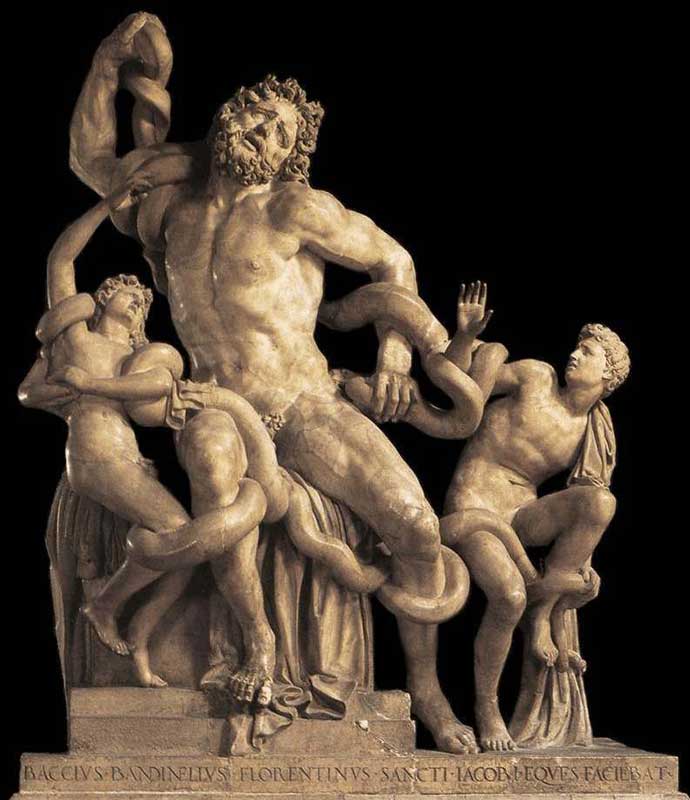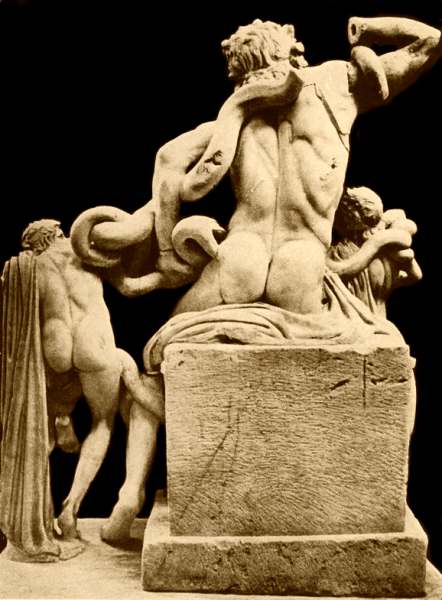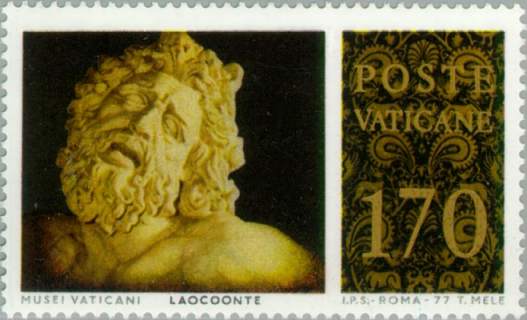.
Hellenistische Kunst. Der Laokoon
Do you believe the enemy have sailed away? Or think that any Grecian gifts are free of craft? Is this the way Ulysses acts? Either Achaeans hide, shut in this wood, or else this is an engine built against our walls... I fear the Greeks, even when they bring gifts, Laocoon from Virgil The Aeneid
Part 1

A Laoccon version where the right hand ist higher than the original not reconstructed version (see image of the original below)
It was 13 January 1506 when Michelangelo and his friend Guiliano was called by the Pope Julius II to see a sculpture. It was the sculpture of Laocoon. Michelangelo called it a "portento d'arte" and his friend Guiliano said excited "this is Laoocon as described by Pliny the elder!"
The Laocoon Group, Laocoon or Laocoön or Laokoon (Λαοκόων) (a brother of Anchises a priest of Apollo) sculpture by Agesander (or Hagesander), Athanodorus and Polydoros of Rhodes a marble copy of a bronze Hellenistic sculpture at 140 BC. Vatican Museum Rome (one of two versions, the other without the restorations of the missing parts).Now it is considered as the work of the three sculptors
1)Athanadoros son of Hagesandros,
2) Hagesandros son of Paionios
3) Polydoros son of Polydoros of Rhodes
Pliny describes the work as that of Hagesander, Polydoros and Athanadoros the Rhodians probably because there was another Athanadoros of Hagesander in Rhodes 42 BC whereas the Scylla of Sperlonga was produced by the same three sculptors in 14-19 AD.
Incredible agony and suffering is contained in the face of Lacoon with a head titled looking. His sons both look to their father with fear, and the statue seems life like with the abundance of emotion. The distended muscles of Laocoon show the intensity of his struggle. ... Laocoon’s sons look towards their father with fearful eyes, in need of help, but Laocoon is already embroiled in his own struggle, a sea serpent biting his side. Laocoon reaches towards the sky, beckoning a reason for his suffering. The Laocoon is truly a miraculous sculpture; the emotion and excitement of Laocoon’s epic struggle is frozen in one single pose. Steffi Julia Cerato,The Artistic Accomplishment of the Hellenistic Era
Laocoon was a Trojan Priest who warned the Trojans not to accept the Greek wooden horse. He inserted his spear into one side of the Trojan horse to see if it was empty. In order to prevent Laocoon to discover the Greeks inside the horse Poseidon (and Athena) sent immediately two serpents who killed him and his sons.
Furthermore, many have little fame, because despite the distinction of their work, the number of artists involved becomes a barrier to recognition, since no single man monopolizes the credit, nor can several of them be recognized on equal terms. Such is the case with the Laocoon in the palace of the emperor Titus, a work to be preferred to any other painting or sculpture. From one stone the eminent craftsmen Hagesander, Polydorus, and Athenodorus of Rhodes made him [Laocoon] and the extraordinary intertwining coils of the snakes, following a plan agreed in advance. Pliny, Natural History

He strains his strength their knots to tear,
While gore and slime his fillets smear,
And to the unregardful skies
Sends up his agonizing cries.
Laokoon’s expression, since discovery in 1506, has been described as either restrained and dignified, or as the ultimate depiction of physical and psychological pain; he has been criticized for not looking toward his children attacked by snakes or justified as raising his eyes to the gods in reproach. Yet an examination of Laokoon’s eyes has revealed that the once-painted irises had no pupils, as if struck by blindness—a rendering corroborated by a late imperial author, Quintus of Smyrna, whose Ilioupersis retains echoes of an earlier tradition , BRUNILDE SISMONDO RIDGWAY, The Study of Greek Sculpture in the Twenty-first Century.
The father has become powerless among the coils of the serpent; the younger son has still strength for resistance but is wounded; the elder has a prospect of escape. From a 1911 encyclopedia.
One of the sons seems to have survived as Actinus of Miletus reports:
The Trojans were suspicious of the wooden horse and standing round it debated what they ought to do. Some thought they ought to hurl it down from the rocks, others to burn it up, while others said they ought to dedicate it to Athena. At last the third opinion prevailed. Then they turned to mirth and feasting believing the war was at an end. But at this very time two serpents appeared and destroyed Laocoon and one of his two sons, a portent which so alarmed the followers of Aeneas that they withdrew to Ida. Arctinus of Miletus Destruction of Troy
There is also a story that Laocoon was punished because Apollo was angry seeing Laocoon sleeping with his wife in the presence of his image in his Temple More Info about Laocoon
The sculpture was found in Rome on January 13, 1506 near the site of Neros Domus Aurea or 'Golden House'. The discovery was such a great event that the bells of all Roman churches rang when the group was transported to the Vatican. A missing fragment of the sculpture was found in Rome in 1957 (Michelangelo correctly knew how the position of this missing part of a right arm was). The Laocoon Group influenced the work of Michelangelo and others.
Historical Miniatures, by August Strindberg (Note this is not a historical accurate text and some fictional parts probably added by Strindberg):
On the Esquiline Hill in Rome, on a spring day in 1506, Signer de Fredis was walking in his vineyard. The day before, his workmen had been digging a pit to seek water, but found none. Signer de Fredis stood by it, and asked himself whether it was not a pity that so much earth had been thrown out, and whether it could not be utilised in the vineyard. He felt about with his stick in the upper part of the pit to ascertain how deep the soil was. The stick sank in the earth up to its handle without meeting with any resistance.
"There must be a hollow under the ground," he said to himself. He first thought of calling the workmen, but since it was better to make the discovery himself, he took a mattock and spade and set to work. By noon he had made a hole large enough to get through, but since it was pitch-black inside, he first went to fetch a lantern. Carrying this, he went down into the earth, and came into a vaulted room. He went through five rooms and found no treasures, but in the sixth he saw a sight that startled him.
Two enormous snakes had enfolded in the coils a bearded man of heroic stature and his two boys.
One snake had already bitten the man in the right side, and the other had bitten one of the boys in the left. The apparition was a statue of Pentelic marble, and might therefore possess as much value as a treasure. Signor de Fredis went at once to the Prefect of the City, who followed him in company with the Aedile and some learned antiquaries. The work of art was brought to the light, and inspected. Its subject was seen to be the Trojan priest Laocoon, against whom Apollo had sent two snakes because he had warned his countrymen against receiving the dangerous Greek gift of the Trojan horse, in which warriors lay concealed.
It was not an edifying story, nor a comforting one, since it illustrated the sad lot of a prophet in this world. The Romans, however, did not think of that, but greeted the statue as a sign of the Renaissance, a memorial of the classical period, and an omen of better times to come.
Pope Julius II bought the Laocoon for the Vatican, after Michael Angelo had declared it was the greatest work of art in the world, and Signor de Fredis received a pension for life. The excavation and cleaning of the statue took a considerable time. But when at last it was ready, it was decorated with flowers, and carried in procession though the streets of Rome, while all the church-bells rang for a whole hour.
As the procession passed up the Via Flaminia, an Augustinian monk came down it from the northern gate of the city. In front of Hadrian's triumphal arch, he met the crowd carrying their beloved Laocoon. The monk did not immediately understand the matter. He thought, it is true, that the statue was that of a martyr, but could not think of any martyr who had died in a pit of snakes. He therefore turned to a citizen, and asked in Latin, "Which of the holy Church martyrs is it?"
The citizen laughed as at a good jest, but did not think it necessary to answer.
Now came the crowd singing about the Trojan horse, and jesting about priests. The fact that it was a priest on whom the snakes had fastened seemed to afford especial delight to the sceptical and priest-hating rabble.
The Augustinian monk thought of his Virgil, when he heard the word Troy, and, as the statue came nearer, he could read the name Laocoon, the celebrated priest of Apollo. "Are the church-bells ringing for that?" he asked his neighbour again.
The latter nodded.
"Are the people mad?" he asked, and this time he received an answer: "No, they are wise; but you are somewhat stupid; probably you come from Germany."
A charcoal sketch found in 1976 on a wall in the Sacristy of San Lorenzo in Florence shows the head of a bearded man seen from above; it was probably made by Michelangelo, from memory, reflecting his first glimpse of the Laokoon while being excavated in Rome. Brunilde Ridgway, Laokoon : The Reading of a Masterpiece
Why was the Laocoon Group produced? Maybe an answer that I have found:
Bernard Andreae (Laokoon und die Gründung Roms. Mainz 1988) sees the sculpture as a symbolic content with political intentions, for him it is more than a mere illustration of the myth. In his opinion the sculpture was manufactured in 139 BC in Pergamon, created as a gift to the Roman commander Scipio Africanus, the destroyer of Karthago. The Laokoon-group was supposed to symbolise the fall of Troja; Laokoon’s doing, that can be seen as a sacrifice for the foundation of Rome, was to promote their political good-will towards Pergamon, since Pergamon, just like Rome, claimed to have Aneas (who understood Laokoon’s warning and fled Troja) as founder and thought of itself as the risen Troja. According to this, the Laokoon group is not only to be read as an illustration of a myth but as a symbol of the destroyed city, as a memorial and at the same time as an utopian reference to a new beginning. (It is interesting that the monument “The Destroyed City” by Ossip Zadkines in Rotterdam, 1947, shows a distinct reference to Laokoon) (From http://www.kingston.ac.uk/fineart-socrates/2diete.htm )

The original not reconstructed version from behind. The image shows how important the facial expression is in the Laocoon Group.
The struggle; vain, against the coiling strain
And gripe, and deepening of the dragon's grasp,
The old man's clinch; the long envenomed chain
Rivets the living links,, -- the enormous asp
Enforces pang on pang, and stifles gasp on gasp.
Byron Childe Harold

A Vatican Stamp
| Ancient Greece
Science, Technology , Medicine , Warfare, , Biographies , Life , Cities/Places/Maps , Arts , Literature , Philosophy ,Olympics, Mythology , History , Images Medieval Greece / Byzantine Empire Science, Technology, Arts, , Warfare , Literature, Biographies, Icons, History Modern Greece Cities, Islands, Regions, Fauna/Flora ,Biographies , History , Warfare, Science/Technology, Literature, Music , Arts , Film/Actors , Sport , Fashion --- |

